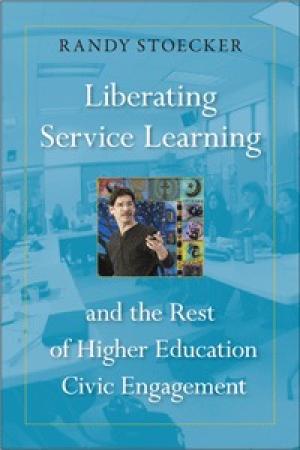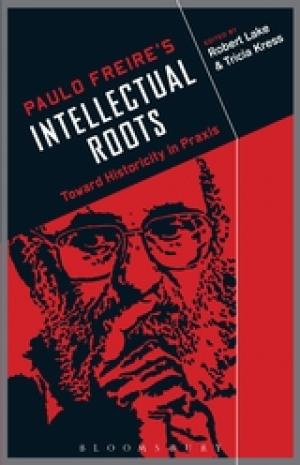Resources by Andrew B. Irvine

The double entendre in this book’s title may be clichéd but it is often apt, and in this case Randy Stoecker makes a strong argument that service learning and the rest of higher education civic engagement (“service learning” functions as a catch-all term) is in need of liberating so that it can be liberating. Stoecker accuses “institutionalized service learning” (ISL), as he calls the prevailing practice, of reinforcing an oppressive neoliberal political-economic order. As a faculty member of the University of Wisconsin, he speaks from experience. What keeps most service-learning practitioners captive, Stoecker asserts, is a failure to theorize about how service learning does and/or could operate. He offers a theoretical view that enables him to (1) reflect on and criticize ideas in current practice and (2) project alternative ideas as points of articulation for liberating service learning – in both senses alluded to above. Stoecker develops his vision in twelve chapters divided into three parts. A “prelude,” “interlude,” and “postlude” provide other vantage points, ironizing Stoecker’s implied authority on the matters at stake and illustrating metaphorically the problems and promises of service learning. An index of names and topics is also provided. Part I, “The Problem and Its Context,” surveys the current state of ISL. In chapter 1, beginning with a critical incident from September 2013 – a disciplinary hearing for students who, in support of labor unionization efforts at the University of Wisconsin, occupied the Chancellor’s office – Stoecker explicates his worries about who ISL truly serves. In chapter 2 he recounts the emergence and eventual institutionalization of service learning in U.S. colleges and universities from the late nineteenth to early twenty-first century, emphasizing evidence that suggests ISL has come to serve bureaucratic requirements rather than community initiatives. Chapter 3 makes a preliminary analysis of the avowed and actual theoretical commitments of current practice, pointing to a need for sustained examination of the meaning of four core concepts: learning, service, community, and change. Part II deepens the analysis. The author argues that ISL supposes “learning” is for students to accrue from service. “Service,” then, means charitable giving, rather than helping communities learn how they might wield their own power. So concepts of “community” in ISL neglect political-economic issues of structural injustice. Accordingly, “change” comes to be seen as a matter of advancing individuals within an unquestioned neoliberal order. Part III re-envisions the core concepts. The crucial move is to start with a critical theory of “change” as social change. In this light “community” may be grasped not as a vague given but as a goal; “service”is seen not as charity but as casting our lot together to form community and effect change; and “learning” means learning to be learners in service to a shared struggle for change – in short, learning to be liberated. Although Stoecker offers something to annoy everyone, I still recommend Liberating Service Learning for its challenging examination of the spirit of service learning, in its present state and as it might be in future.

Best known for his Pedagogy of the Oppressed (New York, N.Y.: Herder, 1970), Paulo Freire (1921-1997) criticized a “banking model” of education − the deposit of knowledge possessed by the teacher into the vacant minds of students. Education should enable students to discover the knowledge they need to become free participants of their society, Freire argued, but the banking model reinforced subordination and acquiescence. Beginning in the 1950s in his native Brazil, before exile made him internationally important, Freire spent his career developing a vision of teaching as a dialogical encounter between teacher(s) and student(s): both have knowledge, and teachers cannot know what and how to teach their students for freedom unless they submit to be taught by the students, too. Freire reflected on this experience and vision at length in the first chapter of Pedagogy of Hope (New York, N.Y.: Continuum, 1993), and a nice feature of the present volume is the inclusion of that chapter as an epilogue. This volume corrects a distorted perception of Freire’s thought. Too often, Freire’s dialogic approach is taken in an anti-intellectualistic way to mean that the teacher has no particularly privileged knowledge to impart; consequently, the deep meaning of Freire’s pedagogy as a critical praxis by which students can appropriate the knowledge of privilege to liberate themselves is lost. This point is central to the introduction by Stanley Aronowitz, “Paulo Freire’s Pedagogy: Not Mainly a Teaching Method.” In addition, the prologue by Henry Giroux and the afterword by Peter McLaren provide orientation to the spirit and urgency of Freire’s work. McLaren puts well the necessity of a volume such as this by stating, “Without a careful reading of Freire’s intellectual roots, one can only witness the collision [between dreams of a better future and the supposed reality of the present situation] without understanding the systems of intelligibility that make such a collision inevitable and without understanding the possibilities of sublating such a collision in order to bring about alternative futures linked to the sustainability of the planet and humanity as a whole” (235-36). Thirteen writers contribute ten essays on thinkers, movements, and concepts crucial to Freire’s philosophy. They cover Hegel, Marx, Gramsci, Habermas, Buber, Fromm, Latin American liberation theology, praxis, conscientizaçao (“conscientization”), and oppression. With one serious exception, the authors manage to balance two important purposes: to introduce their subject in the subject’s own right for readers familiar with Freire but not with intellectual history, and to focus on illuminating in Freire’s work their subject’s influence. Some authors even carry out a valuable third task of criticizing and reconstructing Freire’s ideas so as to extend his thought. Especially noteworthy in this regard are Raymond Morrow in the Habermas chapter, and Sandy Grande, who, in the chapter on oppression, turns Freire’s idea to confront the dispossession of indigenous peoples. Although this is a useful volume, the significance of “historicity in praxis” could have been explicated more forthrightly to knit the entire collection together. Some unevenness means there is still room to improve on our appreciation of Freire’s thoughtworld. Still, this collection is an important contribution to scholarship and teaching practice.